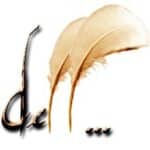
23 French Reading Resources to Help You Practice (and Enjoy!) French
As a French language learner, you can access a lot more written French than you might know about.
You’re not limited to learner content, either—native text-based French content (online and offline) is available in spades.
But don’t worry: I’m not going to send you out there with no guidance whatsoever.
In this post, I’ll set you up with 23 awesome French reading resources accessible to learners of all levels.
Contents
- Finding Native Content for Learners
- 23 Native Resources for Your French Reading Fix
- And one more thing...
Download: This blog post is available as a convenient and portable PDF that you can take anywhere. Click here to get a copy. (Download)
Finding Native Content for Learners
“Okay,” you say. “I’m sold. But where does this native content come from, exactly?”
That’s a good question. If you check online chat and Q&A forums for questions from French learners, you’ll find a lot of people asking exactly that.
And it’s often met with answers along the lines of “Read Le Petit Prince. Read Camus. Advance your level so you can get into more advanced material. You just have to work harder.”
Here’s the thing: no matter your level, tackling whole books with no light reading in between can be discouraging. Heck, even Le Petit Prince takes plenty of linguistic chin-ups to level up to.
So what is the alternative? Consider, if you will, the following.
Content for Children
Just as French children’s books are an option for beginning readers, some French sites offer material specifically for kids. Language learners often miss these sites because they aren’t advertised as being for French learners.
Content for Advertising
Speaking of advertising, it doesn’t pay to sell your product using big words or long, complex sentences.
French ads aren’t going to use tedious or confusing phrasing. Approaching the French language from this perspective opens up even more options for learners.
Content for Entertainment
With the evolution of viral buzz sites and social media that value quick, easy explanations, everything online is getting simpler. Some may see that as being a bad thing, but for language learners, it’s great!
It means you can read what everyone else is reading from the get-go, without having to build up a huge vocabulary first.
When I say “entertainment,” I also mean literally everything you read when you’re browsing popular media. For example, you might not realize it, but if you’re watching a video with French subtitles, then you’re reading.
The above list is by no means exhaustive, but it’s a good place to start. Now, let’s take a look at some real resources that will give you enough practice reading in French for your level.
23 Native Resources for Your French Reading Fix
Simplified News
What better way to practice reading in French than a daily dose of world events? These news sites will keep you supplied with a steady stream of easy-to-read French content.
Level: Beginner
1. Le français façile avec RFI (French made easy with RFI)
The French news service RFI offers a simplified daily summary of international news in both audio and text format on their website.
These news summaries can be useful for dictation exercises (writing what you hear and checking what you come up with against the text) or just everyday French reading.
2. 1 jour 1 actu (1 day 1 news)
A French news site for children, 1 jour 1 actu seeks to appeal to kids without being condescending or shying away from important issues. “actu” is short for “actualité” (news), and the name of the site refers to the fact that they post one new story per day.
Aside from written news, you can also find videos, podcasts and even games on a variety of subjects to make your learning even more engaging.
3. Le journal des enfants (The Children’s Journal)
Another site for kids, this one lets you browse news stories through card-like images.
Updates are more sporadic, but the content is high-quality and it more closely resembles an actual news site.
However, if you want to truly make the most of this site, you have to subscribe to read the articles with the lock icon.
Shopping
When you’re browsing items online, you can exercise your basic French vocabulary by recognizing the names of colors and objects. Since online shopping almost always involves photos, you’ll also be able to make educated guesses at words you don’t know.
Level: Beginner
4. La Redoute
A sale site with thousands of listings for clothing, furniture and toys, La Redoute is a great resource for brushing up on your vocab as well as learning new words from context.
You might know the word chaussures (shoes), but how about escarpins (heels)? Pretty soon you’ll be a French fashion and interior design expert ready to embark on a French shopping adventure.
5. Leboncoin.fr
Leboncoin is a resale/classifieds site that serves all of France. As the home page is a map with clickable regions, it’s as useful for practicing your geography as it is for your vocab.
Also, as I mentioned earlier, even if you need a dictionary to figure out what every other word means, the images in context should be enough to tell you what you’re looking at.
6. eBay.fr
Pretty self-explanatory, right? It’s worth noting, if you’re not a frequent eBay user, that they’re actually pretty snazzy these days.
More warehouse-chic than warehouse, the site reads like an online catalog. Featured collections are set off with short descriptive paragraphs that will gently nudge you toward an intermediate French level.
Travel
Travel sites offer a huge variety of simplified content in the form of pictures and lists. Plus, they can be a lot of fun.
Take the opportunity to plan an imaginary vacation to a French-speaking country. If nothing else, it’ll be good practice for the real thing.
Level: Beginner
7. SNCF Connect
This is a trip-planning site run by France’s government-owned railway company, the SNCF. That’s the Sociéte nationale des chemins de fer français. (See if you can work that mouthful out if you don’t already know what it means.)
With ads for packages, and a ton of transportation and lodging options to play with, you can spend hours here, soaking up knowledge like nobody’s business.
8. Promovacances (Vacation promos)
An intuitive site, Promovacances displays vacation packages with corresponding photos and hotel descriptions in short, bulleted lists.
The site also provides files for hotels with tabs that organize info into categories like FAQs, activities and the how-tos of transportation.
The best part? You won’t only be using this site to learn French (though that’s definitely a bonus), but also to book a trip to some of the French-speaking world’s most breathtaking destinations.
Trends and Entertainment
Sites that feature trending content are a fun way to learn to read French. Since these places tend to have a certain recognizable edge to their humor, they introduce you to the language’s distinct personality early on.
Level: Beginner
9. Topito.com
A fun, popular French site designed to be read second-to-second, you’ll find listes (lists) browsable by category here.
You can amuse yourself with Topitrucs, short reviews of products that are funny, weird or just weirdly specific.
And if you want to really transform this into a French learning resource, you can also take their quizzes!
10. Skyrock
Skyrock is a huge French social networking site worth checking out just because it’s so popular. It’s also a good source for quick music and movie news.
Announcements and plot summaries, while they may contain colloquialisms you’ll need to work out, are short and to the point. You can access the music and movie blogs directly at music.skyrock.com and cine.skyrock.com, respectively.
Comics
As you know, comics are a big deal in France and Belgium. You may already be familiar with some of the classics: Astérix, Les Schtroumpfs (The Smurfs) and Tintin, just to name the biggest ones.
Outside of French graphic novels, bandes dessinées (BD), as we like to call them, are one of the best resources for French reading practice.
Level: Beginner
11. Oui, c’est ça! (Yes, that’s right!)
Oui, c’est ça! is a treasure trove of French online comic strips.
You can choose your level of French (beginner, intermediate or advanced), and see what you stumble upon!
12. Le Petit Quotidien (The Little Daily)
For beginners with slightly shaky French, try Le Petit Quotidien‘s BD du jour (comic book of the day).
The target age on these are 6-10, so the French isn’t too complicated, but you’ll still get the fun of comic strips.
However, as you can see, you need to sign up to see the comics. Once you get past that, have fun reading!
13. Delitoon
Do you like comics with a manga/manhwa style? You’ll find a large array of those on this site for free.
Many of the works on Delitoon.com are in the romance genre, and they range in “heat levels” from cheesy cute to sizzling sexy.
Get lost in comic after comic after comic until you basically come out fluent on the other end.
FluentU takes authentic videos—like music videos, movie trailers, news and inspiring talks—and turns them into personalized language learning lessons.
You can try FluentU for free for 2 weeks. Check out the website or download the iOS app or Android app.
P.S. Click here to take advantage of our current sale! (Expires at the end of this month.)
Recipes
Ask the average person what they know about French cuisine, and chances are they’ll mention “snails,” “ducks” or “cream.” If you’re not that into the gallons (or more appropriately, liters) of cream and (the sometimes raw) meat, you can certainly find a French take on your home-spun favorites.
French cooking may seem daunting at first, but after trying the recipes from the resources below, you may be surprised at how accessible it actually is.
Level: Beginner to intermediate
14. Marmiton
This site not only hosts thousands of recipes, but also has a random recipe (recette au hasard) feature, which you can click to make any, well, random recipe appear.
Plus, the site has cooking videos if you want to see first-hand how it’s done. And if you see any cooking appliances you’d like to have for yourself, you can add them to your shopping cart.
15. Cuisine AZ
Cuisine AZ is especially good for beginners because it has a section for easy recipes, as well as boasting the same video feature as Marmiton.
(Also, not to get sidetracked, but did you notice that the logos for Marmiton and Cuisine AZ have a red or reddish hue to them? That’s because red stimulates the appetite. Now that’s a good start for a French conversation!)
16. “La Cuisine du marché” (lit. “Market Cuisine”) by Paul Bocuse
“La cuisine du marché” is filled with over 150 recipes of traditional French cuisine.
It’s presented by the late Paul Bocuse, a French chef who was one of the pioneers of nouvelle cuisine, a style of cooking that concentrates on fresh and delicate dishes and how they’re presented.
A couple of Bocuse’s signature dishes include the Black Truffle Soup VGE (a chicken broth that has foie gras) and filet of red mullet.
17. “Tout Robuchon” (lit. “All Robuchon”) by Joël Robuchon
“Tout Robuchon” is a cookbook by another late and great French chef, Joël Robuchon. When someone can elevate French cuisine (which is already an institution in itself) to a whole ‘nother level, you know that someone is good.
In fact, Robuchon was so good that he scored an impressive 31 Michelin Stars for his restaurants—more than any other chef in the world. So basically, you know the recipes in this book are going to have mouthwatering results if you follow them in letter and spirit.
Flash Fiction
If you’re not a literature geek, you may not be familiar with flash fiction. Whether it’s French or English, flash fiction is often defined as prose shorter than 1,500 words. Some of these pieces get as itty-bitty as 300 words or less.
These stories are truly a test of word-efficiency, and the writers who do it well will surprise you with how much they can pack into so few words.
Level: Intermediate to advanced
18. Short Édition
Short Édition hosts more than just tiny stories (as you can see under the “Nouvelles” section). They also have regular length short stories and poems.
You can look through their flash fiction by genre or check out the winners from their flash fiction contests.
Also, they’re committed to spreading the wonders of reading wherever they go, so know that whenever you’re browsing through their site, you’re making a difference in your own way.
19. De Plume en Plume (lit. From Feather to Feather)
For user-written flash fiction (and perhaps the best place to post your own attempt at flash fiction), check out De Plume en Plume’s histoires très courtes (very short stories) section.
Don’t let the fact that the stories are user-written put you off. You might be pleasantly surprised at the gems you’ll find!
20. “50 Micronouvelles” (50 Microfiction Stories)
Need a book recommendation instead? Check out this free Kindle download of “50 Micronouvelles” by 50 different authors.
Between these over four dozen stories, I’m sure you’ll have something to fill the time whenever you have a few minutes to spare—and learn some nifty French along the way.
In fact, it’ll probably take you a few seconds at most to read each story, as they’re all within 140 characters (yes, characters)—the maximum length of a Twitter status before 2017. (Maybe you’ll find a gem that’ll resonate with you the way “For Sale. Baby Shoes. Never Worn.” did.)
Movie Reviews
Calling all movie buffs! Take your French cinema obsession a little further, and see what the professionals think of all the films you love.
If you’ve had trouble getting in that much-needed French reading practice because you’re just not that into books, then use this method as an extension to your French film marathons.
Level: Intermediate to advanced
21. Allociné.fr
If you’re not already familiar with Allocine.fr, now’s the time to get with it! It’s the French equivalent of English-language sites like IMDb and Rotten Tomatoes, making it one of the best places to get ahold of movie reviews.
Simply search the site for the movie you want to read critiques for, and scroll to the bottom of the movie’s page for “Critiques Presse,” where it’ll link you to blurbs. If you want to read an entire review, it’ll lead you right to the review from the original website or online magazine.
22. Première
Première is a French site about movies, TV, trailers and all things entertainment. If you want to read movie reviews specifically, just look for the ones with “[critique]” in the title.
Otherwise, have fun browsing through all the latest articles on onscreen entertainment from within and outside France!
23. La Presse (The Press)
Unlike Première, La Presse covers general news as well and is based in Canada.
If you’re looking to brush up on your Canadian French, this is a good site to practice reading and get a feel for the similarities and differences between Canadian and European French.
Of course, as promised, this site is also packed with movie reviews by French speakers based in Canada.
And there you have it! Your gateway to French reading practice and hours of fun. If you use these resources regularly, your options for reading in French will swiftly multiply.
Download: This blog post is available as a convenient and portable PDF that you can take anywhere. Click here to get a copy. (Download)
And one more thing...
If you like learning French on your own time and from the comfort of your smart device, then I'd be remiss to not tell you about FluentU.
FluentU has a wide variety of great content, like interviews, documentary excerpts and web series, as you can see here:

FluentU brings native French videos with reach. With interactive captions, you can tap on any word to see an image, definition and useful examples.

For example, if you tap on the word "crois," you'll see this:

Practice and reinforce all the vocabulary you've learned in a given video with learn mode. Swipe left or right to see more examples for the word you’re learning, and play the mini-games found in our dynamic flashcards, like "fill in the blank."

All throughout, FluentU tracks the vocabulary that you’re learning and uses this information to give you a totally personalized experience. It gives you extra practice with difficult words—and reminds you when it’s time to review what you’ve learned.
Start using the FluentU website on your computer or tablet or, better yet, download the FluentU app from the iTunes or Google Play store. Click here to take advantage of our current sale! (Expires at the end of this month.)


























